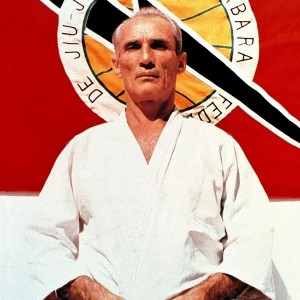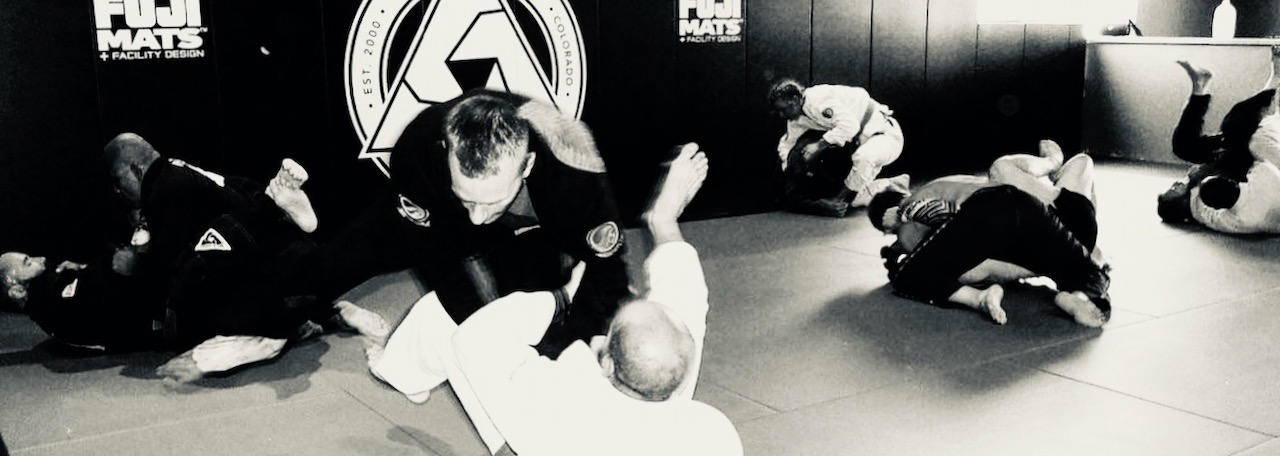THE ART OF GRACIE JIU-JITSU
The application of traditional Gracie Jiu-Jitsu transcends the application of chokes, joint locks, immobilizations, throws, and strikes. Gracie Jiu-Jitsu is a way of life. Beyond the mat, members of the Gracie family live balanced, healthy lives based on the same philosophy that governs their unique self-defense system. Grand Masters Carlos and Helio Gracie believed that the principles of efficiency, patience, and control held the key to success in all aspects of life.
Efficiency
Efficiency, the ability to achieve maximum output with minimum input, is a core principle of Gracie Jiu-Jitsu.
- In Gracie Jiu-Jitsu, we assume that your attacker will always be larger and more athletic than you.
- Our students quickly learn that the only reliable way to succeed is to exhaust your attacker while conserving your own energy through the use of leverage-based techniques and natural body movements.
- In life, as in a fight, a student who learns to expend energy efficiently will achieve maximum results with minimal effort.
Patience
Patience is often the key to success in a struggle against a larger opponent. Usually, it is not the person who attacks the most, but the one who exhausts the least who will win. Acting impulsively, aggressively, or without focus wastes energy.
Patience also applies to timing. Even a perfectly executed technique will fail if attempted at the wrong time. Also in life, patience and timing enable you to “make your own luck” by calmly watching and waiting until the right moment when you can apply your energy most efficiently.
- Being patient with your friends and loved ones, as well as your enemies, is Gracie Jiu-Jitsu.
- Allowing impulses to pass before acting is Gracie Jiu-Jitsu.
- Taking a deep breath and considering all alternatives before committing is Gracie Jiu-Jitsu.
- Patience and timing allow you to know when to commit while efficiency ensures that you have sufficient energy to achieve your objective when the time is right for action.
Control
The final objective in a fight is to impose your will on your opponent. Nothing achieves this more quickly than physical domination after which surrender usually follows.
- Physical domination means controlling your opponent. Without control, you risk losing the fight.
- In life, control applies not only to a simple contest between you and an opponent, but also to the struggle within yourself.
- Self-control reflects your personal discipline and is the foundation for every decision you make in life.
- Without self-control, you risk a lifetime of poor choices that invariably lead to tragic consequences.
Gracie Jiu Jitsu Belt-Levels
The belt level ranking system is a way to help instructors and students identify progress and help provide an additional aspect of motivation. The four colored belts utilize a four stripe/degree system to indicate incremental progress. Black belt and up has a different progress ranking system.
White Belt
![]()
This is the introductory level belt held by practitioners who are new to the art.
- This rank focuses on fundamentals, position, defense, and escapes, although attacks and submissions are also introduced at this level.
- This is a time to start becoming aware of basics and gaining experience of the foundation of jiu-jitsu.
Blue Belt
![]()
This is the second rank for adult level Jiu-Jitsu.
- A student at this level should begin gaining a more acute level of comprehension and application of techniques, while performing and practicing a lot of mat time.
- There should be progress shown towards defense, preventative defense, position advancement, timing and a variety of attacks and submissions.
Purple Belt
![]()
This is an intermediate level adult rank.
- At this level, practitioners should have a wide range of knowledge and detailed understanding of techniques and theories.
- They should be able to apply and articulate moves (defensive and offensive) with details on application, timing, purpose and variations.
- This level is qualified to help instruct lower-level students.
Brown Belt
![]()
This is the highest level “colored” belt before black belt.
- A practitioner at this level typically has put in anywhere from five to seven years of dedicated training.
- It is often considered a time to refine and perfect your techniques, explore variations and your own style.
- Brown belts are also qualified for instructing lower level students and colleagues.
Black Belt
![]()
Similar to other martial arts, the black belt is considered and awarded for expert level technical and practical skill in the art.
- Practitioners who have achieved a black belt often have invested thousands of hours into practice and experience.
- A black belt will hold in-depth knowledge, wide spectrum of techniques around the art
- This level should have the ability to practice and perform all aspects of the art at an expert level, such as takedowns, stand-up self-defense, submissions, variations and series’, solid comprehension of defense, strategy, timing, theory and technique. (The average time to earn a black belt is about eight to ten years.)
Black/Red Belt (Coral Belt)
![]()
This is a major honor and milestone in the art and culture of jiu-jitsu.
- When a Brazilian Jiu Jitsu practitioner achieves seventh degree, the artist is awarded an alternating red-and-black belt also known as Coral Belt.
- This level is given to practitioners who have an extremely high level of experience and knowledge from decades (approximately 30 years) after reaching black belt and whom have had a continuing large impact on the art, both as an instructor and practicioner.
note: Not all BJJ schools, federations, leagues, lineages recognize this belt color yet.
Red Belt
![]()
According to Gracie family members, Renzo and Royler Gracie, in Brazilian Jiu-Jitsu, the red belt is reserved “for those whose influence and fame takes them to the pinnacle of the art”. It is awarded in lieu of a ninth. A red belt holder would be addressed in the art as Grandmaster. It is the highest belt in the art awarded to a living practitioner. This level is awarded to those who have had at least 40+ years at black belt level. (10th degree was only awarded to the pioneers of Gracie Jiu Jitsu, the founding Gracie brothers.)
Kids Belt Ranks
Practitioners under the age of 15 will utilize the following belt ranking with a four stripe incremental system.
White Belt
![]()
This is the starting belt rank for all Jiu-Jitsu practitioners. This is a time for students to start learning fundamentals and basics, such as position and defense. Offense and attacks are also introduced at this level.
Yellow Belt
![]()
Yellow belt is for kids who are starting to progress into their training. This is a time for students to start increasing awareness of position and fundamental application. They should also begin honing in on offense and attacks.
Orange Belt
![]()
This belt level focuses on increasing technique knowledge and options, both offense and defense, refining fundamentals, strategy, and begin exploring widening their skillset.
Green Belt
![]()
Green Belt is the highest rank for a student under the age of 15, before they start training with adults. A green belt should have strong understanding of fundamentals and application, wide array of knowledge and experience of offensive attacks and defensive tactics, takedowns and self-defense, and a more acute awareness of opportunities and strategy.
Promotions
All students are different in performance, pace and progress, thus the time between promotions for students may vary and is determined by all of our qualified black belt instructors and are carried out when the head instructors determine it is appropriate.
YOU define the belt, the belt does NOT define you!
There are no special abilities, skills, knowledge or powers that come with any belt. Your abilities do not change the moment you receive any belt. It is simply a progress indicator of where your skills are relative to your potential.
- A student should be able to demonstrate their belt level’s expected various techniques for self-defense, attacks & offense, takedowns, guards and position advancement, increasing in knowledge and execution improvement as you progress to more advanced belt levels.
- Demonstrating this does not come in the form of a formal test in our academy, but rather with class participation, time in the art and on the mat, showcasing techniques while sparring/rolling with instructors and fellow students, assisting fellow students, patience, perseverance, and respect.
We also want to emphasize that it is NOT about the “color” belt you have or will achieve. IT IS about the knowledge, experience, techniques, and skills that YOU will learn throughout YOUR entire jiu jitsu journey.
Grand Masters
There are about forty 9th degree red belt holders in the world. Here are just a few: Carlson Gracie, João Alberto Barreto, Alvaro Barreto, Pedro Valente Sr., Rorion Gracie, Relson Gracie, Geraldo Flôres, José Higino, Paulo Mauricio Strauch, Mestre Alvaro Barreto, Joao Alberto Barreto, and handful more.

Note: 10th degree red belt was awarded to only the pioneers of Brazilian Jiu Jitsu, the Gracie brothers: Carlos Gracie, Gastão Gracie, Jorge Gracie, and Hélio Gracie.
It is said, that if a Jiu-Jitsu practitioner received his or her black belt at the age of 19 (the earliest one could earn a black belt), they might be able to expect to earn ninth degree near the age of 67 pending that they have a continued dedicated lifestyle towards the art and have met the criteria recognized by the IBJJF.
Some information referenced via Wikipedia: The Free Encyclopedia. Wikimedia Foundation, Inc. 26th Dec 2014. Web. 10 Mar 2015. http://en.wikipedia.org/wiki/Brazilian_jiu-jitsu_ranking_system
Learn more about the History of Gracie Brazilian Jiu-Jitsu
Thinking about training Jiu-Jitsu?

